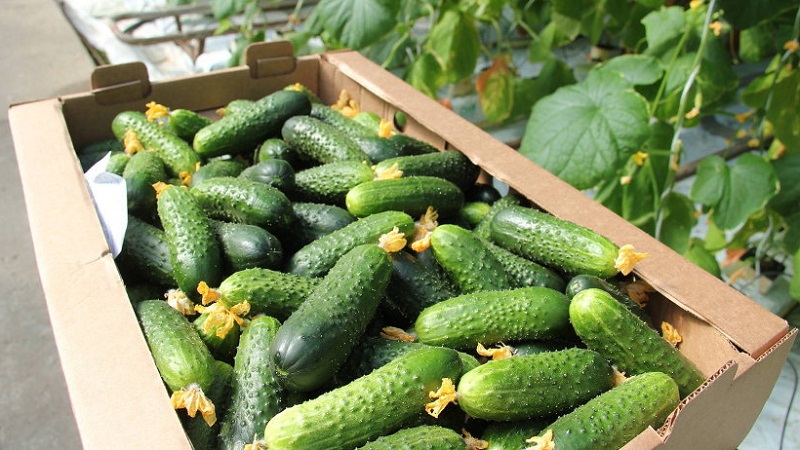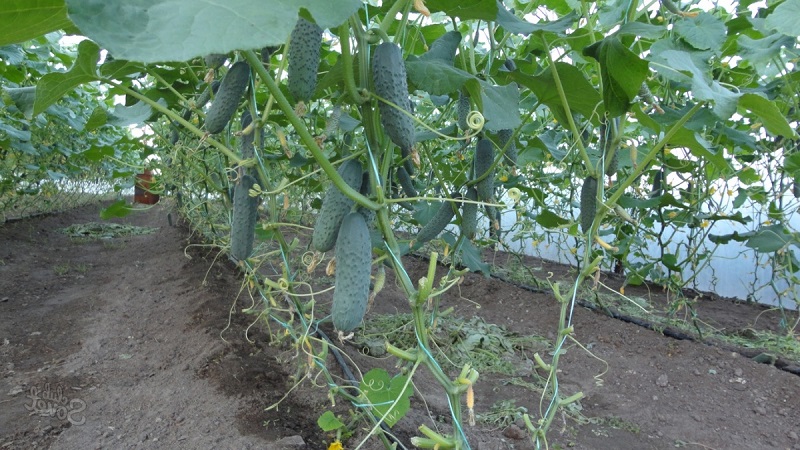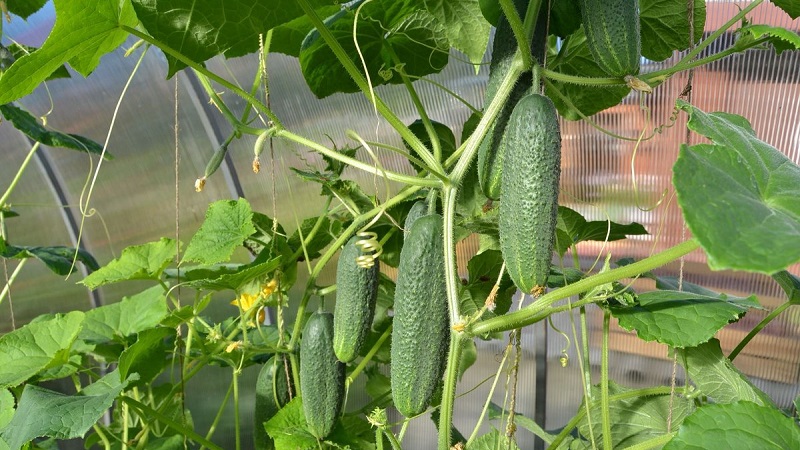What is the yield of cucumbers in a greenhouse from 1 square meter and how to increase it
How many cucumbers can you pick from your greenhouse garden? What varieties to use and what to do to increase the yield? You will find the answers to these questions below. We will tell you in detail how many kilograms can be harvested from one bush and square meter, why the yield depends and how to increase it. And the recommendations of experienced gardeners will help ensure an unprecedented collection of vegetables to the envy of neighbors.
The content of the article
- What is the yield of cucumbers in a greenhouse from 1 square meter and what does it depend on
- The most productive varieties for greenhouses
- How to increase yields
- How many cucumbers can be collected from 1 sq. m in the greenhouse
- What kind of crop can be harvested from one bush
- Helpful advice from experienced vegetable growers
- Conclusion
What is the yield of cucumbers in a greenhouse from 1 square meter and what does it depend on
How many kilograms of vegetables will be harvested from a unit of area directly depends on varieties and quality of seeds, places of cultivation and care. Despite the fact that cucumbers are famous for their early maturity, it is not always possible to grow as much as you want. Average yield of vegetables per 1 sq. m in the greenhouse ranges from 9 to 50 kg.
Reference. In the open field, the yield of cucumbers is four times lower than in a closed structure.
The seed planting scheme also has a great influence on the yield.... The general condition of the plants depends on the density of the arrangement of the bushes. The principle “in tight quarters, but not offended” does not work here. A too compact planting creates a favorable environment for the development of the fungus. Empty flowers form on the plant. The cucumber lacks natural resources.

According to experts, the optimal planting density is 3-4 bushes per 1 sq. m... With this arrangement, seedlings do not need to compete for water, fertilizing, and sunlight.
Many factors affect crop yield, but most of them can be influenced by the gardener and achieve a positive result. However, there are some (for example, the quality of purchased seeds), where everything depends on the case.
The main factors affecting the number of pounds harvested:
- grade (usually take parthenocarpic (self-pollinated) varieties and hybrids characterized by early maturity);
- fertilized soil;
- planting time (planted in the spring for the season or grown year-round);
- the density of the arrangement of the bushes;
- correct feeding and abundant watering;
- sufficient level of lighting in the greenhouse;
- correctly set temperature regime, which is in the range from + 20 ° С to + 35 ° С, depending on the growth period (sowing, flowering, fruiting);
- prevention of fungal infections (whitewashing frames with lime, spraying the bushes with a 1% solution of Bordeaux liquid will save you from ascochitis, bacteriosis, cladosporia);
- protection against pests (aphids, spider mites, black fleas);
- regular harvesting, which does not allow overripe fruits.
Ladybugs are often used to combat aphids.... It can destroy up to hundreds of pests per day.
The most productive varieties for greenhouses
Scientists have developed dozens of varieties and hybrids of cucumbers. All of them differ in size, shape and level of fruiting. Some varieties were bred for the street, others for the greenhouse. Therefore, speaking about the yield, it is appropriate to compare indicators for one type of soil. Certainly greenhouse plants, unlike outdoor plants, will always show the best result.

The following varieties and hybrids proved to be leaders in yield in greenhouses:
- Cupid F1... It is recognized as the most productive. Gives up to 50 kg from 1 sq. m. It has a very early ripening period - up to 30 days. It is characterized by a small number of branches.The planting density of this type of cucumber is 3 bushes per 1 sq. m.
- Tom Thumb... Another representative of early ripening cucumbers. Bears fruit on day 38. The mass does not exceed 80 g. The small weight is compensated by a large number of fruits. A characteristic feature of the variety is disease resistance.
- Goosebump F1... This hybrid does not need insects for pollination. It is characterized by beam flowering, which is the key to high yield (up to 28 kg per 1 sq. M).
- Benefit F1... Self-pollinated hybrid. Begins to actively bear fruit on the 45th day. Gives up to 25 kg per 1 sq. m. The key feature is the complete absence of bitterness.
- Tumi... Productivity - up to 11 kg per bush.
- Matrix... Has the same good disease resistance as Thumbnail Boy. In terms of popularity, it surpasses all other varieties. Fruiting up to 30 kg from 1 sq. m.
F1 means that we have a hybrid of the first generation, obtained from crossing two different varieties.
How to increase yields
You can often hear that cucumbers are very unpretentious in nature. However, this is not entirely true. If they are not given proper attention, you can forget about the big harvest. Therefore, after planting, a lot depends on the care.
The main factors affecting yield:
- Pollination... During the flowering period, insects play an important role in the formation of the ovary. You can lure them with plain sweet water (100 g of sugar per 1 liter of water) or pollinate cucumbers yourself, for example, transferring pollen from male flowers onto female flowers with a soft brush. Of course, if self-pollinating cucumber species grow, these pollination methods are useless.
- Lack of side shoots... The grower must take certain measures to eliminate the appearance of additional shoots. Different varieties of crops have their own pinching periods... Usually this procedure is carried out with scissors, sometimes by hand. Cutting off additional shoots enables the plants to use their forces to form ovaries. In addition, getting rid of excess leaves provides more light in the garden.
- Pest control... To protect adult bushes from insects, they resort to a garter of plants. This method also helps to protect cucumbers from mechanical damage. In addition, by preventing the leaves from touching the ground, you will protect them from fungal infections.
- Proper watering... Cucumbers are a very moisture-loving crop. With a lack of water, it will definitely not be possible to get an additional crop. In addition, those fruits that do ripen will taste bitter. It is recommended to water greenhouse plants every 2-3 days. Average water consumption is from 10 to 15 liters per 1 sq. m.
Do not over-water vegetables, otherwise it will lead to soil decay and fungal infection.
How many cucumbers can be collected from 1 sq. m in the greenhouse
Determining the yield of a particular variety from 1 sq. m, it should be borne in mind that usually the average data for the year is given.

Average number
The table shows the average yield indicators for the main greenhouse varieties:
| Name | Productivity from 1 sq. m, kg | Yield per one hundred square meters, kg |
| Amur | 30-50 | 3000-5000 |
| Tom Thumb | 13-15 | 1300-1500 |
| Goosebump | up to 28 | up to 2800 |
| Benefit | up to 25 | up to 2500 |
| Tumi | up to 11 | up to 1100 |
| Matrix | up to 30 | up to 3000 |
Indicators per month, season, year
To find out how many vegetables are harvested on average per month, it is enough annual harvest divided by 12.
If a cucumbers are grown not all 365 days in a row, but only in summer, they talk about the yield for the season. To calculate such an indicator, it is enough to count the number of months of this period, after which the annual yield is divided by 12, and then multiplied by the number of months of the season.
What kind of crop can be harvested from one bush
To calculate this value, you need to take into account that for 1 sq. m usually has four seedlings. Knowing the average annual yield, divide it by four to get the figure for the bush.
If necessary, in the future, you can calculate the value of the yield per seedling per month or per season according to the principle described above.
Important! Some varieties may have a stocking density of more or less than four. Take this into account when calculating the yield for each specific variety.
Helpful advice from experienced vegetable growers
The harvest of cucumbers planted indoors is influenced by the seed preparation process. Experts know that such preparation significantly improves the quality of seedlings.
The whole the process can be divided into such stages:
- To soften the outer shell, the seeds are immersed in water for several hours.
- After that, the liquid is drained, and plant material for impregnation is placed in a saline solution (3 g of salt per 100 ml of water).
- Those the seeds that float to the surface, thrown away.
- The rest are wrapped in a cloth and lowered into a thermos with a water temperature of 40 ° C for three days.
- Then the seeds can be planted in the ground.

After planting for better ripening and correct subsequent storage of the crop experienced vegetable growers advise:
- To carry out the so-called air dressing... To do this, fill the barrel with water and add organic fertilizer (mullein) to it. As a result of fermentation, nitrogen and carbon dioxide, which are necessary for plants, will be released.
- Sharp stop watering when barren flowers... This action will stress the plant, which will result in the intense growth of female flowers instead of male ones. Then resume watering.
- Pay special attention lighting in the greenhouse... Light should be available to vegetables at least 12 hours a day.
- Maintain temperature in a greenhouse from + 20 ° C to + 35 ° C, depending on the growth period.
- Do not store cucumbers next to vegetables that emit ethylene. This gas contributes to the overripening of the fetus.
- Use a refrigerator for long-term storage... If cucumbers are placed in a regular tray outdoors, vegetables will begin to change after three days.
Conclusion
Whichever variety of cucumber you choose to grow, follow the advice of an experienced grower. There is nothing difficult in properly preparing the seeds for planting or competently caring for the plant as it grows. And in gratitude for your efforts, a few extra pounds of fresh vegetables will be waiting for you.